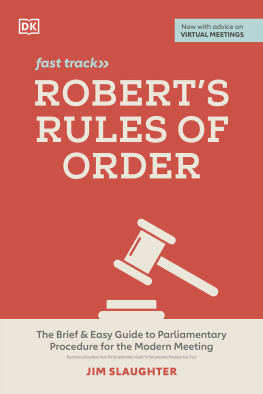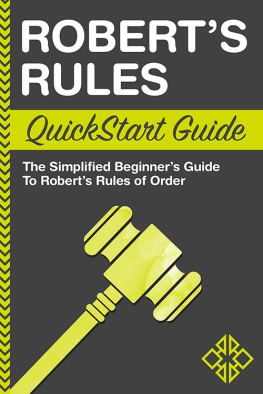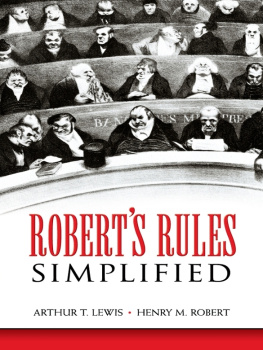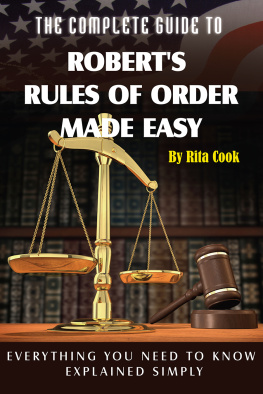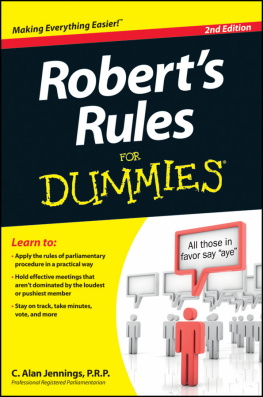Henry M. Robert III - Roberts Rules of Order Newly Revised
Here you can read online Henry M. Robert III - Roberts Rules of Order Newly Revised full text of the book (entire story) in english for free. Download pdf and epub, get meaning, cover and reviews about this ebook. year: 2020, publisher: PublicAffairs, genre: Religion. Description of the work, (preface) as well as reviews are available. Best literature library LitArk.com created for fans of good reading and offers a wide selection of genres:
Romance novel
Science fiction
Adventure
Detective
Science
History
Home and family
Prose
Art
Politics
Computer
Non-fiction
Religion
Business
Children
Humor
Choose a favorite category and find really read worthwhile books. Enjoy immersion in the world of imagination, feel the emotions of the characters or learn something new for yourself, make an fascinating discovery.

- Book:Roberts Rules of Order Newly Revised
- Author:
- Publisher:PublicAffairs
- Genre:
- Year:2020
- Rating:3 / 5
- Favourites:Add to favourites
- Your mark:
- 60
- 1
- 2
- 3
- 4
- 5
Roberts Rules of Order Newly Revised: summary, description and annotation
We offer to read an annotation, description, summary or preface (depends on what the author of the book "Roberts Rules of Order Newly Revised" wrote himself). If you haven't found the necessary information about the book — write in the comments, we will try to find it.
Roberts Rules of Order Newly Revised — read online for free the complete book (whole text) full work
Below is the text of the book, divided by pages. System saving the place of the last page read, allows you to conveniently read the book "Roberts Rules of Order Newly Revised" online for free, without having to search again every time where you left off. Put a bookmark, and you can go to the page where you finished reading at any time.
Font size:
Interval:
Bookmark:
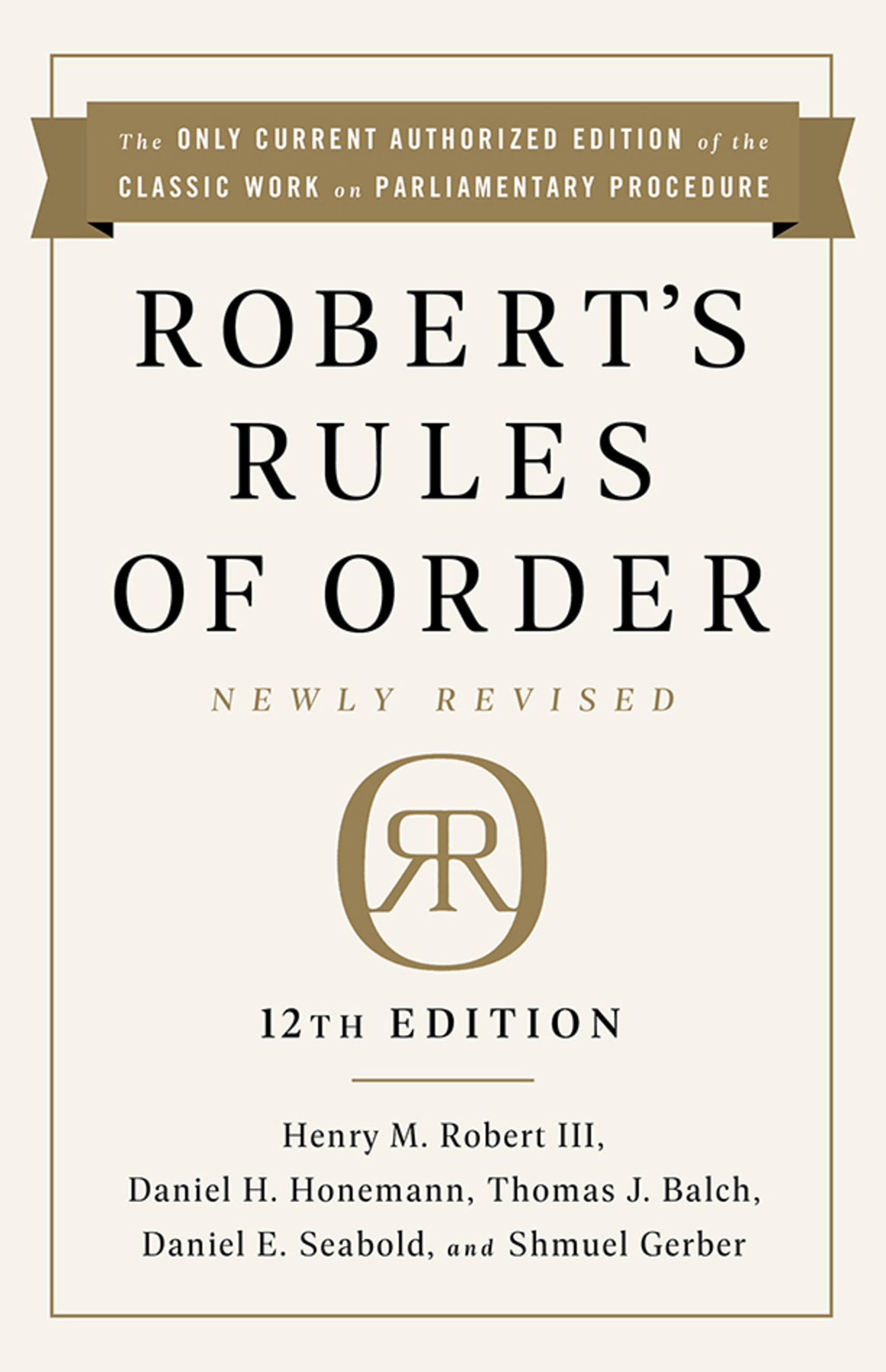
Copyright 2020 by the Roberts Rules Association
Copyright 1970, 1981, 1990, 2000, 2011, by Henry M. Robert III, Trustee for the Roberts Rules Association
Copyright 1943, 1951 by Isabel H. Robert
Copyright 1876, 1893, 1904, 1915, 1918, 1921 by Henry M. Robert
Cover design by Pete Garceau
Cover copyright 2020 Hachette Book Group, Inc.
Hachette Book Group supports the right to free expression and the value of copyright. The purpose of copyright is to encourage writers and artists to produce the creative works that enrich our culture.
The scanning, uploading, and distribution of this copyrighted work without permission is a theft of the authors intellectual property. If you would like permission to use material from the book (other than for review purposes), please contact: Barbara Redgrave Holloway, Authors Agent, Roberts Rules Association, 6630 St. James Court, Downers Grove, IL 60516 (bholloway14@comcast.net). Thank you for your support of the authors rights.
PublicAffairs
Hachette Book Group
1290 Avenue of the Americas, New York, NY 10104
www.publicaffairsbooks.com
@Public_Affairs
Twelfth Edition Hardcover, Paperback, and Deluxe Editions: September 2020
Published by PublicAffairs, an imprint of Perseus Books, LLC, a subsidiary of Hachette Book Group, Inc. The PublicAffairs name and logo is a trademark of the Hachette Book Group.
The publisher is not responsible for websites (or their content) that are not owned by the publisher.
For questions and answers and further information on parliamentary procedure visit www.robertsrules.com.
Library of Congress Cataloging-in-Publication Data has been applied for.
ISBNs: 978-1-5417-9771-0 (hardcover); 978-1-5417-3669-6 (paperback); 978-1-5417-9805-2 (deluxe); 978-1-5417-5109-5 (ebook)
E3-20200821-JV-NF-ORI
This edition, published on the 50th anniversary of the first in the Roberts Rules of Order Newly Revised series, is dedicated to the memory of Sarah Corbin Robert, William J. Evans, and Henry M. Robert III, who were principally responsible for its creation.
Where there is no law, but every man does what is right in his own eyes, there is the least of real liberty.
HENRY M. ROBERT
It is difficult to find another branch of knowledge where a small amount of study produces such great results in increased efficiency in a country where the people rule, as in parliamentary law.
HENRY M. ROBERT

See
with section and paragraph numbers as in the following examples:
RONR (12th ed.) 12:67
RONR (12th ed.) 12:7(1)(a)
RONR (12th ed.) 35:1012
Footnotes may be cited as follows: RONR (12th ed.) 56:49n1
This Twelfth Edition supersedes all previous editions and is intended automatically to become the parliamentary authority in organizations whose bylaws prescribe Roberts Rules of Order, Roberts Rules of Order Revised, Roberts Rules of Order Newly Revised, or the current edition of any of these titles, or the like, without specifying a particular edition. If the bylaws specifically identify one of the eleven previous editions of the work as parliamentary authority, the bylaws should be amended to prescribe the current edition of Roberts Rules of Order Newly Revised (see ).
| () | A boldface number, usually enclosed in parentheses, refers to an entire section (here section 13). |
| Two numbers, separated by a colon, refer to a paragraph. The first number indicates the section in which the paragraph is located and the second number indicates which paragraph within that section is referenced (here the first paragraph in section 13). |
| cf. | compare to (confer) |
| e.g. | for example (exempli gratia) |
| ff. | and the paragraphs following the given paragraph |
| n | The letter n following a paragraph number indicates a footnote. Notes are numbered consecutively within each chapter. |
| p., pp. | page, pages |
| t48 | A number preceded by the letter t indicates a page within the Charts, Tables, and Lists, whose pages are tinted gray on the outer edges. |
Also see , Notes on Example Format Throughout the Book.
This Twelfth Edition of Roberts Rules of Order Newly Revised (RONR) is issued one hundred forty-four years after the 1876 publication, by then-Major (later Brigadier General) Henry M. Robert, of the first in the series of books familiarly known as Roberts Rules of Order. A complete list of the editions is shown on page vi, and their history is told in the Introduction.
This Twelfth Edition in the entire series is the sixth edition of the second complete reworking of the subject matter first published in 1970. It is the only book in print containing the completely developed body of rules understood as Roberts Rules of Order.
Users of this work should be aware of three important resources that supplement RONR.
First, for some time there had been a felt tension between the need for a parliamentary manual lengthy enough to provide rules as comprehensive and unambiguous as possible so as to cover the great number and variety of parliamentary issues that may arise in a deliberative assembly, on the one hand, and the desirability of a book simple and straightforward enough to allow the ordinary meeting-goer easily to learn and use the basic rules that are sufficient for most meetings, on the other hand.
When this book last underwent complete revision in 1970, a concerted effort was made to enhance the value of the work for the study of parliamentary lawto the extent consistent with its primary purpose as a reference manual. For those who will brave it, it is written to serve as a self-explanatory text that can be read through, with topics presented in an order that will best convey an overall understanding of the subject matter. Nevertheless, it is recognized that this project may be a bigger challenge than many newcomers to parliamentary procedure will find themselves at first able or willing to take on.
In 2005, to meet the need for a simple and short book, Roberts Rules of Order Newly Revised In Brief was first published. A new edition of In Brief, updated and revised so as to mesh with this Twelfth Edition, has now been published. This Twelfth Edition of RONR, the complete rule book, now contains 633 pages of text, plus tables and charts. All of its content has to be included because it may be needed and has at some time come up as a question of procedure somewhere. This book is designed as a reference providing, as nearly as possible, an answer to any question of parliamentary procedure that may arise.
To gain an introductory familiarity with meeting rules, however, many people will find it useful to start with the In Brief book. In only thirty minutes, the average reader can learn the bare essentials, and with about ninety minutes reading can cover all the basics. Additional chapters give suggestions on how most efficiently to use this Twelfth Edition of RONR as a reference manual and guidance to those chosen as convention delegates or alternates, or as president, vice-president, secretary, or treasurer of an organization. Helpful tables at the end give both the chair and the ordinary member the proper wording to use in handling the most common motions and conducting a meeting.
Font size:
Interval:
Bookmark:
Similar books «Roberts Rules of Order Newly Revised»
Look at similar books to Roberts Rules of Order Newly Revised. We have selected literature similar in name and meaning in the hope of providing readers with more options to find new, interesting, not yet read works.
Discussion, reviews of the book Roberts Rules of Order Newly Revised and just readers' own opinions. Leave your comments, write what you think about the work, its meaning or the main characters. Specify what exactly you liked and what you didn't like, and why you think so.


